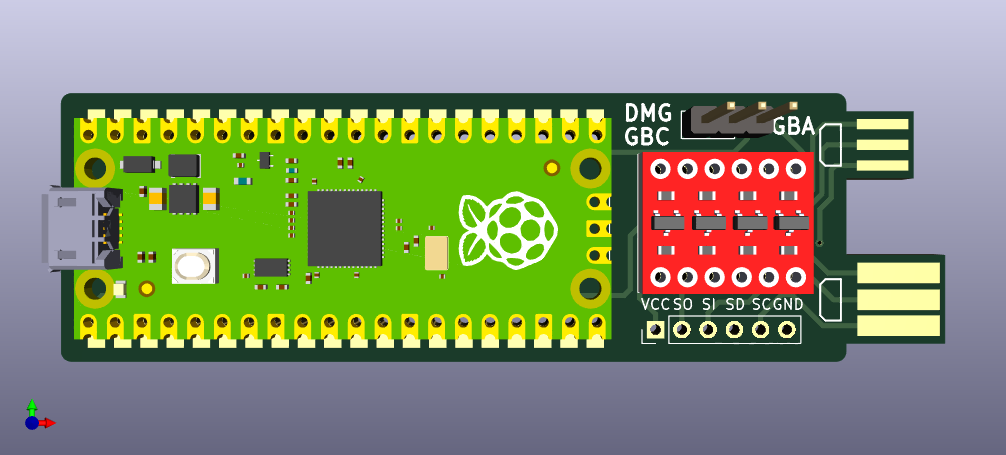An Open-Source USB to Gameboy Link Cable Adapter for Raspberry Pi Pico. Designed with components that are easy to source and solder.
Based on stacksmashing Gameboy Link adapter: https://www.youtube.com/watch?v=KtHu693wE9o
| Reference | Part Number | Description |
|---|---|---|
| U1 | Raspberry Pi Pico | |
| U2 | BOB-12009 | Sparkfun Bi-Directional Logic Level Converter, clones are compatible |
| SW1 | Pin Header | 1x3 2.54mm Male Pin Header |
| - | Pin Jumper | 2.54mm Pin Jumper, harvest from old motherboard or hardrive |
Attached links are for reference only, you can use any equivalent part.
To order a board, use the gerbers.zip from the release page or generate one yourself. You can order from your favourite PCB manufacturer (JLCPCB, PCBWay, etc.).
Use 1.2mm PCB thickness.
You can choose any colour for the Solder Mask and Silkscreen. For the Surface Finish, ENIG is recommended.
- Trim the Link Cable connectors width on the board to the appropriate size using a file tool or sandpaper
- Solder pin header to Raspberry Pi Pico and Level Shifter module. Use a breadboard for easier soldering
- Solder Raspberry Pi Pico and Level Shifter module to the board
- Cut the excessive pin using a nipper tool
- Solder the 1x3 Pin Header to the board, and place the Pin Jumper
- Flash firmware to your Raspberry Pi Pico (see Compatibility)
Connect the board to your PC, and connect the board to your Gameboy using a Link Cable.
For Gameboy/Gameboy Color game, place the pin jumper on the DMG/GBC side. For Gameboy Advance game, place the pin jumper on the GBA side.
Be aware Gameboy/Gameboy Color mode uses 5V logic, while Gameboy Advance mode uses 3.3V logic. Make sure your pin jumper is placed on the correct side to avoid any damage.
This board is compatible with the following firmware:
- https://github.com/stacksmashing/gb-link-firmware
- https://github.com/stacksmashing/gb-link-printer
- https://github.com/Lorenzooone/PokemonGB_Online_Trades
- https://github.com/dj505/GBPrinterEmu
- https://github.com/Squaresweets/GBPrinter-discord-bot
- https://github.com/KuestenKeks/pc-to-gb-printer
With some modification, it should be compatible with other firmware as well, such as:
- Raspberry Pi Pico Footprint: https://github.com/ncarandini/KiCad-RP-Pico
- Logic Level Converter (BOB-12009) Footprint: https://www.snapeda.com/parts/BOB-12009/SparkFun%20Electronics/view-part/
- Gameboy Link Connector Footprint: https://github.com/Palmr/gb-link-cable
- 1.2mm PCB Thickness, based on: https://hackaday.io/project/12932-game-link-online/log/43999-received-the-breakout-boards

